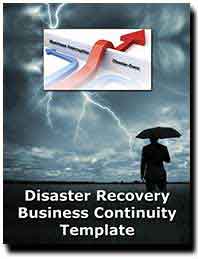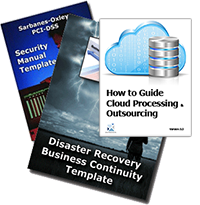Basics for Disaster Planning and Business Continuity
 Basics for Disaster Planning and Business Continuity Template delivered electronically - Planning for busiess and IT disruptions requires an understanding of the essentials of each of these elements:
Basics for Disaster Planning and Business Continuity Template delivered electronically - Planning for busiess and IT disruptions requires an understanding of the essentials of each of these elements:
Keep people working with business as usual
Planning for employees, business partners and customers makes up the most critical aspect of business recovery planning, Janco Associates says. Depending on the nature of the outage, you may need to figure out how and where people can continue working. For a brief period of time, everyone may need to work remotely, but you'll need to have these contingency plans ready, along with automatic notification to tell employees to work at home.
Make accommodations for facilities
Facilities make up an important part of business recovery planning. According to the U.S. National Fire Protection Agency, 35 percent of businesses that experience a major fire are out of business with three years. So, if having everyone work at home is not the best option for your business, recovery vendors can provide interim workplaces such as prefabricated mobile offices or buildings designed specifically for use in times of crisis.
Secure information before the event
Data can make or break a business. According to the U.S. National Archives and Records Administration, 80 percent of companies without well-conceived data protection and recovery strategies go out of business within two years of a major disaster. Backup tape and storage testing services can help ensure that critical data will be available after a major outage. Ideally, says Janco Associates, backups should be performed offsite, preferably at a facility far away from everyday operations. "The best way to protect the information for a small business is to use a remote data backup facility, which actually transmits the data either overnight or at scheduled times to a remote site where it is stored."
Prepare alternate networking routes
Can you keep networks open - or restore them quickly? What happens if you don't have local area network (LAN) or wide area network (WAN) connectivity for an extended period of time? Or phone connections and e-mail? In the worst-case scenario, your business may not have access to any of these vital services. LAN and WAN contingency plans can include services such as remote data access so critical information can be managed and administered from any location. A failover system for e-mail is also highly recommended, who note that keeping in touch with partners and customers can make all the difference in remaining in business. These solutions can be activated in seconds, but keep in mind that these systems need to be in place prior to an outage.
Keep technology up-to-date and aligned with recovery plans
Keep tabs on how technology is applied within your organization. This can be as simple as making sure a security patch has been correctly applied. Otherwise, recovery plans can be easily derailed when new software and hardware is added or upgraded without testing the potential consequences of changes to business technology. That's why experts like Janco Associates recommend routine system checkups, as well as longer-term business continuity and resilience planning services. "Resilience is the ability to take a blow and keep on going," they say.
Regular checkups provide the best results
Janco Associate recommentds business recovery plans be tested at least semi-annually. "Plans go out of date very quickly," he says. "Exercise your plan at least once every six months. People find that's when they realize what they really need to do to improve their plans."
Order Disaster Plan Template Download DRP Customer Base
Cost of No Plan
A plan for disaster recovery and business continuity that helps operations get up and running quickly or keeps them up and running with a minimal loss of data, information and productivity is a necessity. Tools and technologies are available to help mitigate various forms of disaster and to help keep downtime to a minimum.
Even if organizations do have a business continuity and disaster recovery plan in place, they can still face problems. Often that plan doesn't reflect real-world costs.
Nearly every aspect of business today is expected to be available continuously without interruption, regardless of the circumstances. When a disaster strikes - whether a natural disaster or technological failure - enterprise management expect operational services and technologies to still function.
Most organizations need to place a high value on being prepared for disasters of any kind because the practical ramifications of failing to do so can be very high indeed:
- Lost revenue: Even the loss of a single mission-critical service, such as e-mail or web connectivity, can cost some companies millions of dollars in revenue. Avoiding this downtime with a business continuity and disaster recovery plan in place is a clear benefit.
- Customer confidence: When a company experiences an interruption in services or suffers a loss of data, customers can lose confidence in that firm's viability in a crisis and its ability to meet their needs and protect their personal information.
- Compliance penalties and fines: Government regulated businesses found to be in a state of noncompliance could be subjected to lawsuits, fines and penalties.
- Staff confidence and effectiveness: As technology becomes an even greater part of business operations, users have come to rely more and more on services and technologies to do their jobs. When those services or technologies become unavailable, even for short periods of time, users suffer major productivity losses.
- In addition to the direct costs of lost productivity, long-term damage can result in low staff morale and confidence in the organization, extending the monetary damages well into the future, even after services have been restored.
Order DRP BCP Template DRP BCP Sample




